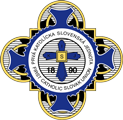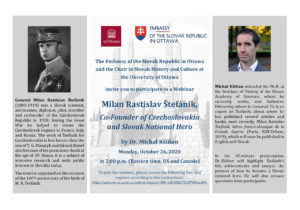It is no secret that immigrants have provided our nation with a strong and blessed support. Our Sisters who emigrated from central Europe have contributed mightily not only by their spiritual presence but also by the works they have performed in convents, parishes, schools, hospitals, homes for the elderly and by their very presence which has brought joy and comfort to all with whom they came into contact. If my calculations are correct, fifty-one Sisters have come to the U. S. to live fruitful lives and to minister to people who always proved to be thankful for their presence. I would like to introduce you to several of these Sisters who made a contribution to the health and well-being of their companions on the journey, especially those whom we called “house Sisters.” Some of them, of course, became teachers in the parish schools and sacristans in parishes and large institutions.
The next Sister I would like to introduce is Sister Albina Maria Žapka, who as a young child growing up in a northern Slovak village, was instilled with a sense of God’s creation and His presence and love.
Her Story:
Sister Albina Maria Žapka 
Sister Stanislaus, who later returned to her secular name, Sister Albina Maria Žapka, was born in Horný Vadičov, a small village about eight kilometers from Kysuca, Trencianska župa, Slovakia. Her father, who came to the U. S. before World War I, saw to it that she and her mother also came to this land of freedom and prosperity. When she was still a child, her parents instilled in her a sense of God’s creation and His presence and love. If today’s parents counted this lesson significant, the dangers of climate change would not be a major issue in our world.
When she was still a toddler, her mother passed an orphanage and saw the Sisters taking care of the orphans. It occurred to her that if her two-year-old wanted to minister to orphans when she became a Sister, she would have no objections. It is worthy of note that when Sister Albina became a Cyrilite, one of her assignments was to the Immaculate Conception Orphanage in Middletown, PA, where she served as prefect of the boys. Just one instance of the hand of God operative in her life.
When she was a little older, just seven, Albina heard two women having a conversation about “nuns.” Since the word was totally unfamiliar, she asked her mother its meaning. Her mother gave her this definition: “a girl who renounces all that is material and worldly and dedicates herself totally to Jesus Christ.” In one of her later writings, Albina exclaimed “What a sublime and heavenly statement this explanation was for me.” She also admitted that in her teen years and young adulthood she did give some consideration to religious life.
Though Albina was in earnest about embracing religious life, she was advised to wait and see, to go to school or get a job. At the time she was living in Bridgeport, CT, and attending Saints Cyril and Methodius parish where Father Gaspar Panik served as pastor. For six years Albina worked in three different factories where she learned how hard people had to work to earn a living. She admits that her vocation was tested–“I enjoyed my independence and having my own money. I even received proposals of marriage, but always in the back of my mind was the thought, ‘Religious life is best for me.’”
When Albina finally decided to take the step she had been considering for some time, she told her employer, Mr. Campbell, of her plans. “God bless you, Albina,” he said, “but I hope you realize convent life is tough.” She admitted that for a moment she was frightened by his comment. Since it was the Great Depression, she naturally feared being unemployed if she did not persevere in religious life so she asked Mr. Campbell if she would be able to get her job back. When he replied, “I will take you back,” she breathed a sigh of relief.
Sister Stanislaus did persevere and over the years was involved in a variety of ministries. She taught in the parish schools and Sunday morning religious education classes and served as a teacher’s aide. Sister was also a sacristan and baked altar breads, served as a dietitian and did other domestic duties and engaged in clerical work and sewing. As was already mentioned, she was boys’ prefect at Immaculate Conception Home in Middletown.
Like the other Sisters from Slovakia who visited their home towns on their jubilees, she had the opportunity to visit Horný Vadičov. Later she traveled to Canada to the shrine of St. Anne de Beaupre. Her most memorable journey was to Rome to attend Mother Katherine Drexel’s beatification. Because her name had been drawn at random, she was able to travel with the group from the Diocese of Harrisburg, PA.
Sister claims that her retirement years were as active as her years in ministry. She collected cancelled stamps for the benefit of the missions and also the congregation. Sister provided spiritual reading for prisoners and collected religious pictures from Christmas and Easter cards which she sent to the Slovak and Czech Republics and also to the St. Jude Ranch for Boys and Girls. She visited at the Danville State Hospital and crocheted baby sets for Birthright and the Maria Hall Craft Department. Sister also found fulfillment in writing letters to the ill and those in distress.
To add to her accomplishments, Sister Albina Maria was a published author. The January 1995 issue of Sisters Today had her article entitled “A Precious Witness, My Crucifix,” which told of her visit to Slovakia during the Communist regime. An area newspaper had a supplement in the 1998 SUSQUEHANNA SENIOR that featured the joy and fulfillment she experienced in her stamp ministry. Also in 1998 the GOOD SHEPHERD published an article on her stamp ministry entitled “Fruitful Retirement Days” and another called “Revisiting My Roots” in which she reminisces about her childhood in Horný Vadičov. Youngsters, she wrote, were taught to practice the Presence of God and to observe the Ten Commandments. They saw firsthand the living out of Christian principles and spiritual practices. When the church bells rang, for instance, men and women stopped to say the Angelus. In order to learn responsibility youngsters were given chores to perform suited to their age. “For example, I was given the task of caring for our geese. I loved the goslings in particular and hugged them to myself while mother goose watched me and her offspring with pride.” The older children were permitted to take care of the cows in the pasturelands. Sister admitted that she “found caring for cows a weighty responsibility, very trying at times, especially during rainstorms.” One hot July day when she was nine her cow Prosie suddenly disappeared. She panicked, but schooled in prayer, she went to the top of the greenwood (haj in Slovak) and fervently prayed the Our Father. When she had finished imploring the Lord for Prosie’s return, she saw the cow prancing down the road. Prosie continued until she found a cool stable, a shady respite from the heat. “I entered the stable, too, and proceeded to discipline Prosie for her reckless behavior and for failing to remain in the pasture where she knew she should be. I thought to myself that my mother would discipline me in this way if I were so disobedient.” Sister shared a number of other tales which were both inspiring and humorous.
Sister Albina retired to Maria Hall in 1993. She died on March 2003, at age 93, and her funeral was celebrated on the Feast of the Annunciation, March 25. On that day at the very time of the funeral in Danville, memorial prayers were offered up in Stratford, CT by Sister Madonna, Mary, Sister Albina’s sister and her friend, Helen.
 THE STAINED GLASS WINDOWS OF THE BASILICA OF SS CYRIL & METHODIUS, DANVILLE:
THE STAINED GLASS WINDOWS OF THE BASILICA OF SS CYRIL & METHODIUS, DANVILLE:
A beautiful reflection on the history of the congregation and the Sisters from the Central European nations who immigrated to serve it
Sister Bernadette Marie Ondus, SSCM
When I know I am to give a guided tour of the Basilica of Saints Cyril and Methodius in Danville, PA, at our Motherhouse, I ask the Lord to send a sunny day. I want the sunlit blue, reds, and greens in the stained glass windows to illumine the glories of our faith and the history of our congregation founded in 1909.
Naturally it is impossible to provide details of all the windows so I highlight a few that are most meaningful and underscore what is important for us to understand today.
After examining the window of Our Lord and the Blessed Mother situated in the front of the Basilica, I turn to the window of our holy patrons, Saints Cyril and Methodius. The bottom panel in the Central lancet shows the mother of the two brothers blessing them before they embark on their journey to central Europe. It is not difficult to imagine what emotions surfaced in all three and perhaps other family members who may have been present. Neither is it difficult to wonder about the experiences they had as they made the journey from Thessalonica to Greater Moravia—without the benefit of a jet liner.
The next window I point out is the window of Slovak history situated on the right in the rear of the Basilica. This window contains the window most central to the issue I want to highlight. Once again in the bottom of the middle lancet we see the first immigrants landing on our soil in 1870. Even though there is no movement in the window one seems to sense what the family must have experienced as they moved forward to Ellis Island with what little they carried with them from their homeland. In the background, however, is a comforting sight, the Statue of Liberty and the words of Emma Lazarus imprinted there, “Give me your tired, your poor, your huddled masses…” Significant also is what is depicted in the panel directly above, the Church of St. Joseph, Hazleton, PA, a spiritual refuge for all who have left their homeland and whose faith will be supported and encouraged in their new home.
The next significant window that bears a special message for us is in the choir loft. To the right is the window of St. Gregory, founder of Gregorian Chant. Then there is the clear depiction of the message of this series of essays: Holy Mother Church is holding her cloak open to protect all classes of people in her motherly care.
At a time when immigration is a controversial issue the window of Slovak history enables us to look back at the history of the congregation and the Sisters from the Central European nations, Slovakia, Austria, Hungary, and Austria-Hungary who entered a young religious community and provided it with a remarkable dedication to God, service to their religious Sisters as well as the people they encountered in their daily ministry.



